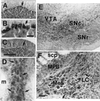Trace amines: identification of a family of mammalian G protein-coupled receptors
- PMID: 11459929
- PMCID: PMC55357
- DOI: 10.1073/pnas.151105198
Trace amines: identification of a family of mammalian G protein-coupled receptors
Abstract
Tyramine, beta-phenylethylamine, tryptamine, and octopamine are biogenic amines present in trace levels in mammalian nervous systems. Although some "trace amines" have clearly defined roles as neurotransmitters in invertebrates, the extent to which they function as true neurotransmitters in vertebrates has remained speculative. Using a degenerate PCR approach, we have identified 15 G protein-coupled receptors (GPCR) from human and rodent tissues. Together with the orphan receptor PNR, these receptors form a subfamily of rhodopsin GPCRs distinct from, but related to the classical biogenic amine receptors. We have demonstrated that two of these receptors bind and/or are activated by trace amines. The cloning of mammalian GPCRs for trace amines supports a role for trace amines as neurotransmitters in vertebrates. Three of the four human receptors from this family are present in the amygdala, possibly linking trace amine receptors to affective disorders. The identification of this family of receptors should rekindle the investigation of the roles of trace amines in mammalian nervous systems and may potentially lead to the development of novel therapeutics for a variety of indications.
Figures





References
-
- Usdin E, Sandler M, editors. Trace Amines and the Brain. New York: Dekker; 1976.
-
- Boulton A A. In: Trace Amines and the Brain. Usdin E, Sandler M, editors. New York: Dekker; 1976.
-
- Juorio A V. Brain Res. 1976;111:442–445. - PubMed
-
- Durden D A, Philips S R. J Neurochem. 1980;34:1725–1732. - PubMed
-
- Grimsby J, Toth M, Chen K, Kumazawa T, Klaidman L, Adams J D, Karoum F, Gal J, Shih J C. Nat Genet. 1997;17:206–210. - PubMed
MeSH terms
Substances
Associated data
- Actions
- Actions
- Actions
- Actions
- Actions
- Actions
- Actions
- Actions
- Actions
- Actions
- Actions
- Actions
- Actions
- Actions
- Actions
- Actions
- Actions
- Actions
- Actions
LinkOut - more resources
Full Text Sources
Other Literature Sources
Chemical Information
Molecular Biology Databases

